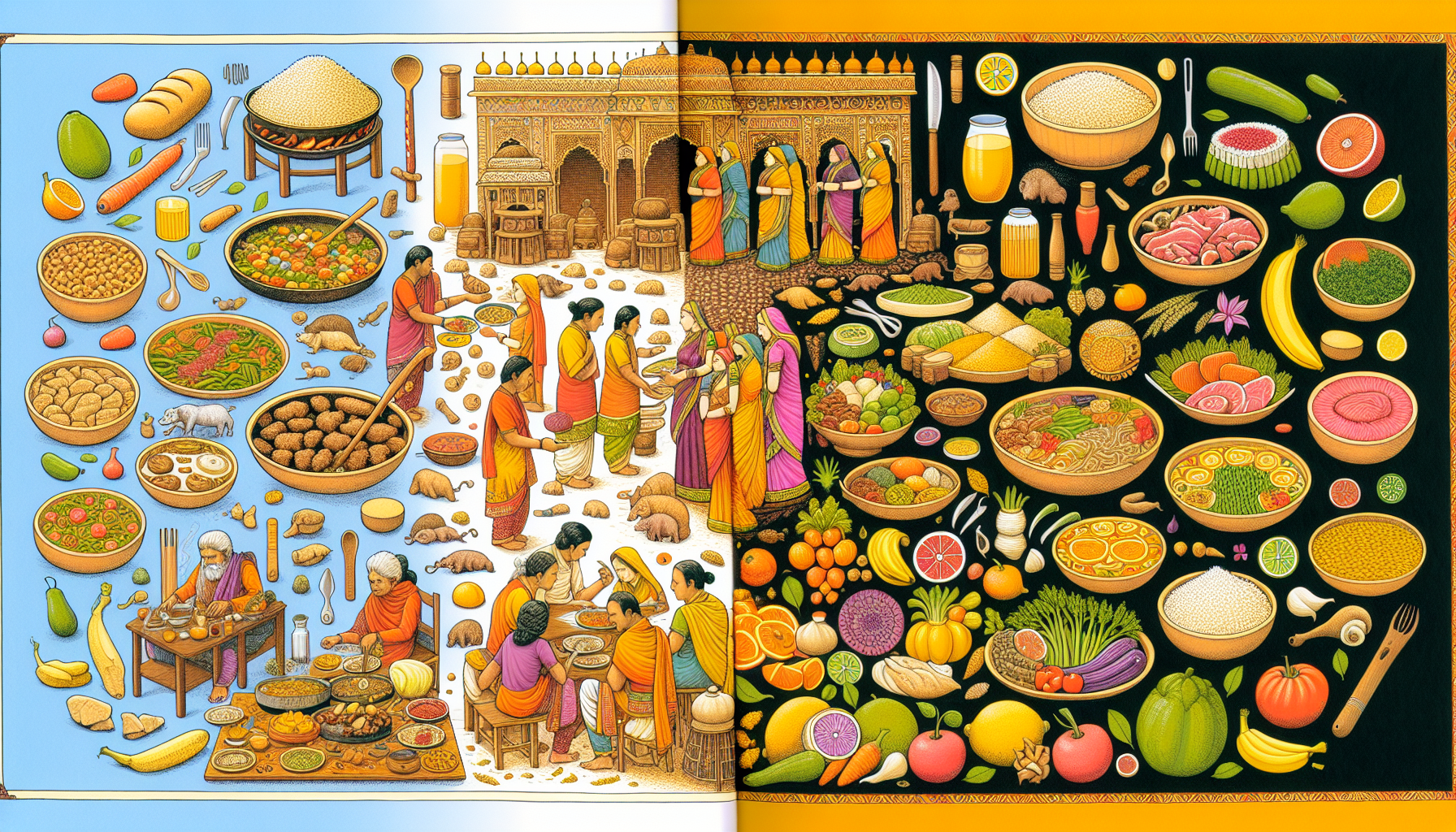- Empty cart.
- Continue Shopping
Ancient Indian Dietary Traditions: From Meat Consumption to Vegetarianism – Vegetarianism

Vegetarianism – # Ancient Indian Dietary Traditions: From Meat Consumption to Vegetarianism
In the annals of history, dietary habits have been shaped by geography, culture, and religion. Ancient India, a land known for its rich and diverse cultural heritage, presents a compelling story in the evolution from widespread meat consumption to a more vegetarian-focused diet. This shift was not immediate but rather a transition influenced by several factors such as lifestyle, religious texts, and the advent of new philosophies. **Vegetarianism** in India today is often seen as a fundamental aspect of its culture, and understanding its roots reveals the intricate tapestry of socio-religious influences that have shaped it over millennia.
## The Dietary Landscape of Ancient India
In the early periods of Indian civilization, dietary practices varied significantly across regions and communities. This diversity largely depended on the **geographical terrain**, availability of resources, and climatic conditions.
### **Meat Consumption in Vedic Period**
During the Vedic period, which dates back to around 1500 BCE to 500 BCE, meat consumption was a common element of the diet. The ancient Vedic texts, such as the Rigveda, contain numerous references to **animal sacrifice and meat-eating**, which played a ritualistic role in religious practices. The sacrifices were offered to deities, symbolizing prosperity and abundance.
- Meat was considered a vital source of nourishment and strength.
- Cattle were highly valued not just for meat but also for dairy and agricultural purposes.
- Consumption often linked with rituals and celebrations, illustrating its significance in societal norms.
## Transition Influenced by Philosophical Texts
The shift towards vegetarianism was not abrupt but was influenced by evolving philosophies and religious movements that began challenging the consumption of meat.
### **Rise of Buddhism and Jainism**
Around the 6th century BCE, the spiritual landscape of India began to transform with the advent of Buddhism and Jainism. These religions advocated for ahimsa or non-violence, which became a cornerstone of their spiritual doctrine.
- **Buddhism**, founded by Siddhartha Gautama (Buddha), emphasized compassion and reduced suffering for all living beings.
- **Jainism**, established by Mahavira, strictly advocated for ahimsa, not only abstaining from meat but also avoiding harm to any life forms.
The influence of these faiths gradually began to percolate through Indian society, edging the people towards a **less meat-intensive diet**.
### **The Role of Mauryan Emperor Ashoka**
One of the pivotal figures in promoting vegetarianism was Emperor Ashoka of the Mauryan Empire, who reigned in 273-232 BCE. After a transformative experience, Ashoka converted to Buddhism and became a staunch advocate of ahimsa.
- Ashoka’s edicts, inscribed on pillars and rocks, emphasized the welfare of animals and promoted non-violence.
- Prohibited the slaughter of numerous species and enforced the vegetarian diet in certain regions under his control.
## The Manusmriti and Moral Vegetarianism
The codification of laws and social guidelines took a definitive turn with the Manusmriti, an ancient legal text that has significantly influenced Hindu cultural and social norms.
### **Manusmriti’s Stand on Vegetarianism**
Compiled between 200 BCE and 200 CE, the **Manusmriti**, also known as the Laws of Manu, became a pivotal document that advocated for vegetarianism as an ideal. While acknowledging the consumption of meat in certain contexts, the text began privileging a vegetarian diet, associating it with spiritual purity and higher moral standing.
- Vegetarianism was portrayed not merely as a diet but as a lifestyle reflecting one’s commitment to morality and spirituality.
- Meat consumption began to be scrutinized critically, drawing lines between necessity and luxury.
### **Influence of Hindu Philosophies**
Over time, Hindu philosophies also began emphasizing vegetarianism through texts like the Upanishads, Bhagavad Gita, and Puranas. These works expanded the discourse on vegetarianism, urging for **self-control, discipline, and purity**.
- Bhagavad Gita exalted sattvic foods, which included vegetables, fruits, and grains, aligning them with mental clarity and spirituality.
- Puranic literature frequently extolled the virtues of vegetarianism, particularly in devotion practices.
## Economic and Environmental Considerations
Dietary choices in ancient India were not solely driven by philosophical and religious ideals but also by practical economic and environmental factors.
### **Agrarian Societal Structure**
Ancient India was largely an agrarian society, where farming formed the backbone of the economy and culture. The symbiotic relationship between the farmer and livestock further accentuated the movement towards vegetarianism.
- Animals, like cattle, were essential for labor, dairy, and farming utilities beyond mere sources of meat.
- The climatic diversity supported a plethora of vegetables and grains, providing viable substitutes to animal protein.
## Regional Variations of Vegetarianism
As vegetarianism spread, it did so with regional twists, reflecting the cultural and environmental nuances of various Indian sub-regions.
### **Northern and Southern Influence**
The **northern** parts of India, deeply embedded in eastern Indo-Iranian traditions, initially witnessed slower shifts. However, the spread of Buddhism created pockets of vegetarian adherents even here.
- The influence of Mughal and Central Asian cooking later introduced an amalgamation of vegetarian and non-vegetarian dishes, evolving traditional culinary arts.
In the **southern** regions, the warmer climate and monsoon-fed lands supported lush harvests of rice, coconut, and spices, cementing a variety of vegetarian cuisines.
- Southern India witnessed less influence from external culinary traditions, allowing vegetarianism to establish firmly.
## The Cultural Legacy of Vegetarianism
Today, vegetarianism in India is not simply seen as a dietary choice but a cultural ethos, interwoven with traditions, rites, and identities.
### **Festivals and Food**
Vegetarianism plays a crucial role in Indian festivals where specific foods are prepared and consumed in adherence to customs.
- Fasting and special vegetarian feasts are part of festivals like Diwali, Navratri, and Pongal.
- Certain days and periods in the religious calendar are marked by strict adherence to meat-free diets.
### **Modern-Day Ethical and Health Considerations**
In contemporary times, vegetarianism is witnessing a global renaissance, driven by ethical concerns about animal welfare and sustainability, and boosted by research on its health benefits.
- India remains a paradigm, contributing significantly to global vegetarian and vegan populations.
- The continued evolution of regional cuisines keeps the traditions vibrant and appealing to the modern palate.
## Conclusion
The transition of dietary practices in ancient India from meat consumption to vegetarianism is a remarkable journey influenced by multifaceted forces. **Vegetarianism**, intertwined with spiritual, philosophical, and practical dynamics, stands today not merely as a code of diet but one that anchors cultural identity, ethical standards, and sustainability. Understanding this evolution offers insight not just into India’s past but into developing informed choices for sustainable diets worldwide.
Unbeatable Pet Accessory Deals on Amazon!
Watch funny and cute dog videos!
Disclaimer: All images featured on this website are either sourced from free-to-use platforms, created by us, or used with permission. If you believe an image on this site violates copyright or your rights, please contact us, and we will address the issue promptly.

















